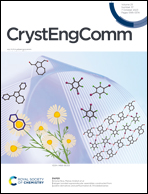Chalcogen bonding interactions in a series of aromatic selenocyanates†
Abstract
Selenium atoms in aromatic selenocyanates are characterized by the occurrence of two σ-holes, a stronger one in the prolongation of the NC–Se bond and a weaker one in the prolongation of the Ar–Se bond. The crystal structures of several bis(selenocyanato) derivatives, prepared by a method originally developed for ortho bis-substituted derivatives, illustrate very well this difference, with a short NC–Se⋯NC ChB interaction organizing the molecules into 1D motifs with reduction ratio (RR) values in the range of 0.87–0.91 (RR is defined as the interatomic distance over the van der Waals contact), complemented with Ar–Se⋯NC ChB interactions between antiparallel chains involving the second σ-hole, with larger RR values in the range of 0.92–0.94. Comparison with benzylic selenocyanates shows that this secondary lateral interaction involving the weaker σ-hole is notably enhanced in these novel aromatic compounds. The structure of co-crystals of the para derivative (1,4-diselenocyanatobenzene) with (E)-1,2-di(4-pyridyl)ethylene (bpen) is characterized by an extremely short NC–Se⋯Nbpen distance at 2.693(2) Å, i.e. a RR value of 0.78, complemented with interaction of the second σ-hole with the π system of the double bond of bpen.



 Please wait while we load your content...
Please wait while we load your content...